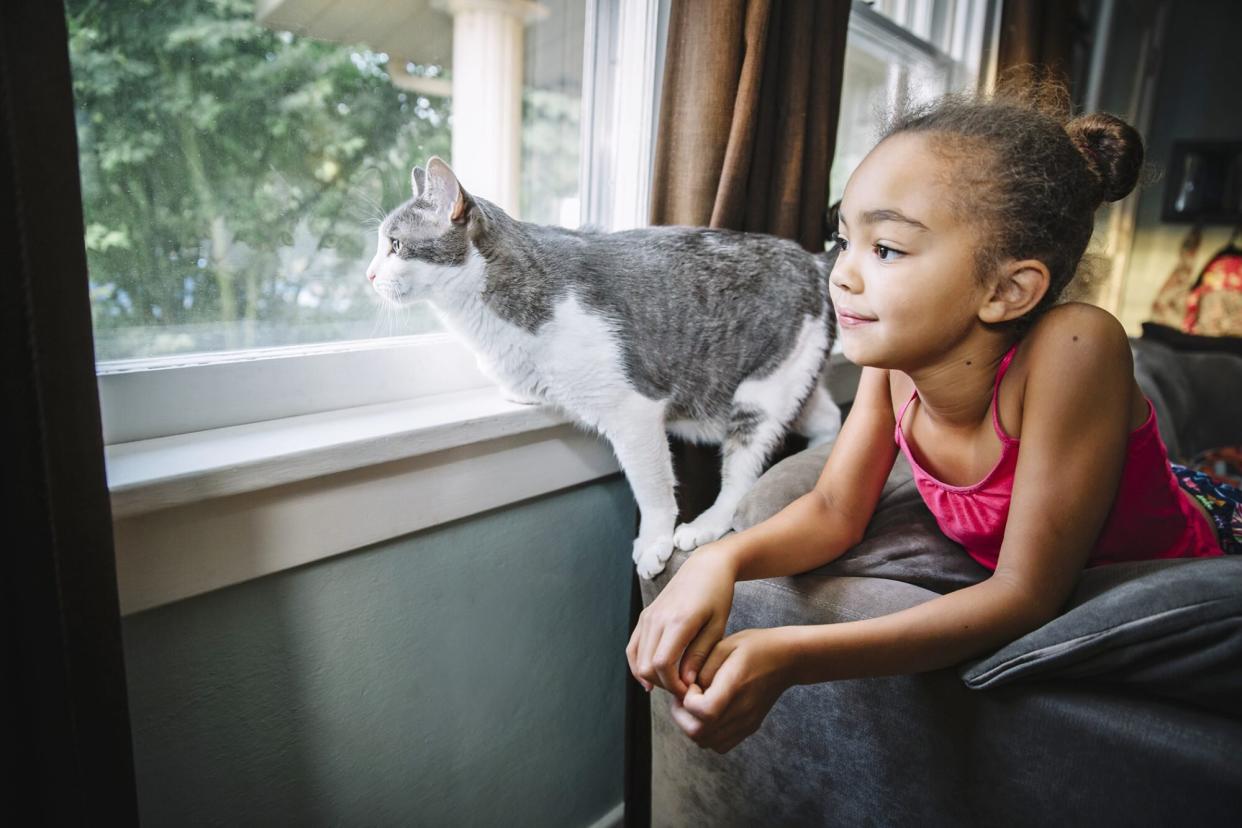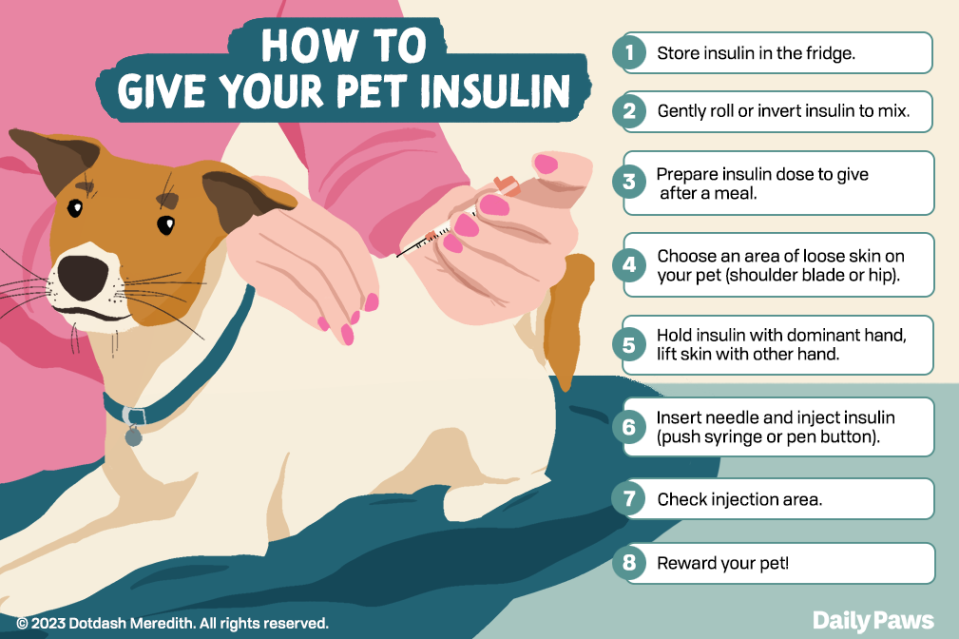Here's Exactly How to Give Your Dog or Cat an Insulin Shot at Home

Inti St. Clair / Getty
TABLE OF CONTENTS
On This Page
What Is Insulin?
How to Give an Insulin Shot
Types of Insulin
Where to Buy Insulin and Supplies
Insulin Storage and Handling
If your pet has been diagnosed with diabetes, then giving insulin is probably going to become part of your daily routine. Fear not! It's not actually that difficult to give insulin shots, and most pets can learn to tolerate it well. Here's how to give your cat or dog an insulin shot at home, plus tips on types of insulin, storage, and handling.
What Is Insulin?
Insulin is a hormone released by the pancreas that manages blood sugar (glucose) by moving it into the cells where it can be stored or used for energy. When a pet or a person has diabetes, either the pancreas cannot make enough insulin or the body does not respond to the insulin as it should. For these patients, insulin is available as an injectable medication used to help regulate blood sugar. Pets with diabetes often need regular insulin injections to maintain healthy blood sugar levels.
How to Give an Insulin Shot

KAILEY WHITMAN
It's normal to feel overwhelmed or anxious about giving your pet an injection. But it may ease your mind to know that the needle is incredibly small and only a small amount of insulin needs to be injected. Most pets respond well and experience nothing more than a tiny pinch. Your vet's office should give you an in-person demonstration to train you on how to give your pet insulin. They're the first place you should call if you run into any issues.
Unless your vet recommends otherwise, it's important to give insulin only after your pet eats. If your pet won't eat, contact your vet for advice. You'll want to check the blood glucose level if you're able to do so at home. Call your vet before giving insulin if your pet is acting sick, lethargic, wobbly, or dizzy.
For the best results, establish a routine of feeding, giving the insulin shot, and rewarding your pet. Here's how to give an insulin shot to your pet at home:
Place a blanket or soft bedding in the location where you'll give the injection. For smaller pets, you may find it easier to use a table, but it can also be done on the floor if you're comfortable.
You may find it helpful to have the syringe or pen ready to go before you get your pet. Bring your pet to the location after a meal. Keep calm and relaxed, and speak in a soothing tone.
Locate an area to give the injection. The best areas are where there's plenty of loose skin. In dogs, good spots are typically along the sides of the spine in the loose skin of the shoulder blades or hips. In cats, the upper back/neck area is often an ideal spot.
Hold the syringe in your dominant hand and use the other hand to lift the skin up to make a "tent" shape. This should provide a triangular area of skin with a flat area. This is where the needle will go.
Gently insert the needle into the skin. There should be no need to jab or poke unless your pet has very thick skin.
Slightly pull back on the plunger using one of your fingers on the hand holding the syringe. If you get blood or air, remove the needle and start again. If nothing is drawn back, push the plunger with your thumb to inject the insulin.
Remove the needle from the skin and carefully dispose of it in a container designed for sharps or biohazard materials (available from a pharmacy or online). Needles should not be thrown into the regular trash.
Check the injection area on your pet. If you notice a wet spot, this likely means not all of the insulin made it under the skin. Do not repeat the injection. Contact your vet for advice about the next step.
That's it, you did it! Reward your pet with praise or a small treat that's approved by your vet for diabetics.
If you happen to accidentally inject yourself with insulin, contact your doctor as this may affect your own blood sugar.
Types of Insulin
There are several types of insulin available for pets, some of which are species-specific. Your veterinarian will determine the best type of insulin for your pet, but here are some of the more common types:
NPH (Humulin): An intermediate-acting genetically engineered human insulin that is often used in dogs and cats
Lente (Vetsulin): An intermediate-acting pork insulin that is nearly identical to canine insulin. It's often used for dogs and sometimes for cats.
PZI (ProZinc): A long-acting recombinant human protamine zinc insulin often used in cats and sometimes in dogs
Glargine (Lantus): A long-acting recombinant human insulin most often used in cats
Detemir (Levemir): A long-acting human analog insulin used in both dogs and cats.
Most insulin comes in a vial and is drawn into a syringe for injection. Some are available as insulin pens, where you measure the dose by turning a dial.
Your vet may need to change the type of insulin used depending on your pet's response. It's important to monitor your pet according to your vet's recommendations. Your pet will need to visit the vet periodically so they can check the blood glucose response to the insulin throughout the day—this is called a glucose curve.
Some people choose to monitor their pet's blood glucose at home using a blood glucose monitor. This requires getting small blood samples from your pet and using a glucometer (it's what diabetic humans often do). It's not as hard as you may think, and your vet can show you how.
RELATED: Feline Diabetes: Could Your Cat Be Diabetic?
Where to Buy Insulin and Supplies
Your veterinarian may be able to sell you insulin and syringes, but sometimes you'll have to get these from a pharmacy. The vet can write a prescription to make sure you get the right type of insulin and the corresponding syringes.
It's important to get the right insulin syringe—they come in two units of measurement: U-100 and U-40. Using the wrong syringe can cause you to give the wrong dose of insulin, which can be dangerous for your pet. Always double check that you're using the syringe that matches the insulin units.
Insulin Storage and Handling
Most manufacturers recommend discarding insulin about 4-6 weeks after first puncturing the vial. But insulin can get expensive, and pets don't generally go through it as fast as people. Fortunately, AAHA guidelines state that "if handled carefully and stored in the refrigerator, the Task Force is comfortable using insulins beyond the date of expiration (up to 3–6 mo) as long as they are not discolored, flocculent, or have any change in consistency. Insulin must be discarded if these changes occur."
When storing insulin in the refrigerator, keep it inside as opposed to on the door because it will be subject to more temperature changes on the door. If your pet is not responding to the insulin as well as before, it's likely time to discard it and open a new vial or pen rather than adjust the insulin dose. Your vet can help you determine what to do.
It's normal for the particles in insulin to settle, so the solution must be gently mixed before drawing it up. Do not shake insulin as this can create small air bubbles that may lead to incorrect dosage. Instead, gently roll the bottle or pen between your hands or carefully invert it several times.
Vials
Uncap your needle and hold the vial upside down. Puncture the rubber stopper and draw back the exact amount of insulin prescribed. If air enters the syringe, gently flick the syringe to get the bubble to rise, then push them back into the vial. Draw it back until the measurement is precise.
Pens
Pens contain a cartridge of insulin inside and a mechanism to measure exact doses. Place a new disposable needle tip on the pen, then twist or click the pen to measure up the exact dose. Pens may vary by manufacturer, so be sure to follow instructions for use.
RELATED: Could Your Dog Have Diabetes? Here's What You Need to Know

